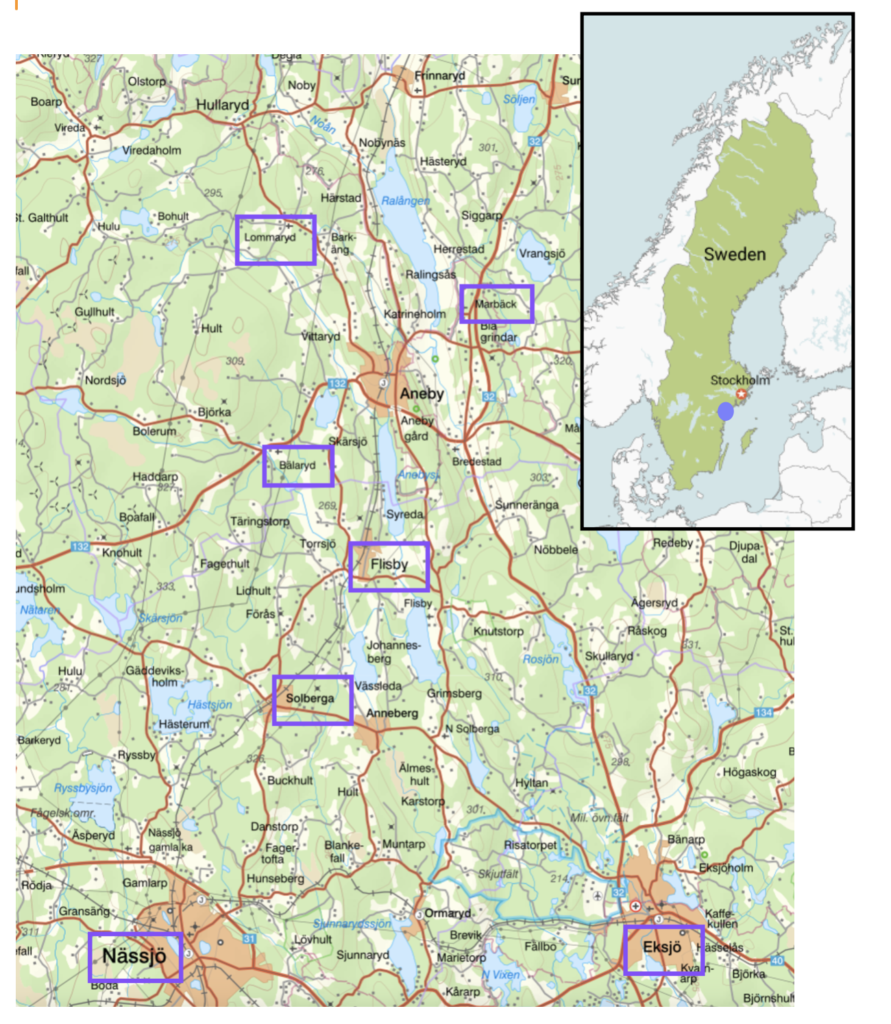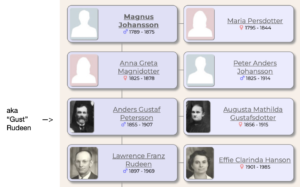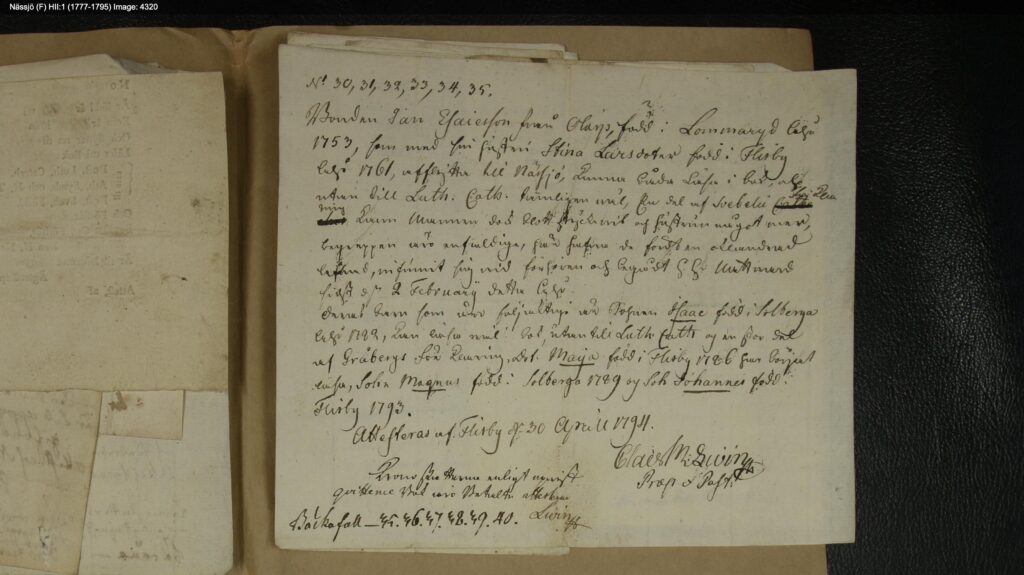Magnus Johansson was my 3x-great-grandfather. He lived in Jönköping län (county) in the historical province of Småland, Sweden.
Download the PDF version of this profile, complete with footnotes and source citations
This diagram shows how my paternal grandfather Lawrence Rudeen is descended from Magnus Johansson.
Magnus was born on October 19, 1789 in the parish of Flisby in Jönköping län on a farm called Kårarp.
| Cast of Characters
Magnus’ Parents: Jän Elaiasson and Stina Larsdotter Magnus’ maternal grandmother (Stina’s mother): Lisken Mathisdotter Magnus’ half-uncle (Stina’s half-brother): Peter Svensson Magnus’ siblings: Isac, Maja, and Johannes Magnus’ wives: Maria Persdotter and Maja Stina Nilsdotter Magnus’ children: Anna Greta, Carl Magnus, and Claës August |
Magnus’ parents were Jän Elaiasson and Stina Larsdotter. The Kårarp farm had been in Stina’s family for at least a couple of generations. Jän was born in nearby Lommaryd parish. Jän and Stina were married in 1779 in Stina’s home parish of Flisby. They soon moved to the nearby parish of Solberga were Jän worked at a rusthåll, a farm which provided financial support to a cavalry regiment. Magnus’ oldest sibling Isac was born there in 1781. A short time later the family moved back to Flisby where their next three children were born. Both daughter Maja and son Magnus were born at Kårarp, the farm where Stina grew up. The youngest son Johannes was born in 1793 on a farm called Olarp – suggesting that by then, the family was finally starting to gain some degree of independence.
In April of 1794, when Magnus was five years old, the family moved away from Flisby to a farm in nearby Nässjö parish. The Swedish National Archives (Riksarkivet) has a copy of the traveling document that was issued by the minister in the Flisby parish and which the family would have had to present to the Nässjö minister upon their arrival. In addition to birth dates and other basic information, the document also gives us a glimpse into each family member’s general literacy and their understanding of Luther’s Catechism.
For centuries, Swedes were subject to annual examinations by priests regarding their ability to read and understand their catechism. Although an oppressive practice, it produced fantastic genealogical records! This document notes that both the husband and the wife can read fairly well and are reasonably well-versed in the the Lutheran Catechism. However, the husband can only write a little bit whereas the wife can write a bit more. The minister notes that “their understanding is simple,” indicating that their knowledge is probably based on rote memorization. The oldest son, Isac, could read fairly well and understood quite a bit of “Gråberg’s” explanations (this was probably a catechism book for children). The eight-year-old daughter had just started learning to read. The parents had received Holy Communion in February of 1794, and “they have led an unblemished life here.” How remarkable that we can see an image of the actual document that the father carried with them when they moved!
Nässjö Flyttning (Moving Certificate), Nässjö (F) HII:1 (1777-1795) Image 4320 (AID: v400219.b4320, NAD: SE/VALA/00283
What the document doesn’t tell us is that Jän was already showing symptoms of tuberculosis at the time of their move. Symptoms probably varied over time, and perhaps when the family made the decision to move they were hopeful that Jän was improving or in remission. But he succumbed to the disease on March 5, 1796, just two years after the family had moved to Nässjö. The death record noted that his illness had lasted four years, with four severe attacks during that time.
Running a farm with four small children was not possible for Stina. The family left Nässjö several weeks later on May 28. Their destination isn’t clear from the records, but it seems likely that they would have returned to the home of Stina’s mother, Lisken Mathisdotter. By 1796, Lisken was herself twice widowed and likely living with her youngest son, Peter Svensson, from her second marriage.
In 1803, Peter and Lisken were living in the nearby parish of Bälaryd but it seems they ha moved back and forth between Bälard and Flisby, even living for a short period of time at the old family farm of Kårarp.
Magnus’ mother Stina remarried in 1805 to Carl Jänsson, a widower with five children. It does not appear that Stina’s young children were part of this new household despite the fact that her youngest, Johan, was only eight years old at this time. Records are a bit scant before 1807, but we see various of Stina’s children living with Lisken and Peter from 1807 to 1813. We can’t be too hard on Stina. A widowed woman had few options for staying out of the poorhouse, and if a prospective husband was not eager to take on step-children, sending her children to live with relatives may have been the only viable choice for their collective survival.
Another point to note is that the head of household was required to pay an annual tax for anyone over the age of 15, including hired help. Once children were of taxable age, poor families often had to send them off to work in a household that could afford the annual tax.
Magnus may have moved away from his grandmother’s home to live and work elsewhere as early as 12 years old (not unusual), but he returned to live with his grandmother and half-uncle in 1807 at their farm in Bälaryd. By then, Magnus was 18 years old and probably able to contribute in a more meaningful way to his uncle’s farm work. He didn’t stay long; at the end of the 1807 farm season, he moved back to Flisby and worked for a year at the Johannesberg estate. He continued moving around on short-term employment contracts to farms in Eksjö and Solberga parishes. Finally in 1809 he moved to Marbäck parish where he would reside for the remainder of his life. In his early years in Marbäck, he worked at the Gåseryd, Herrestad, Öringe, and Högaskog Stora farms.
Such moving around was not uncommon for young men in Sweden during this time. Employment contracts for farm labor ran from October through September. At the end of the contract period, either party could end the arrangement. It’s hard to know for sure whether Magnus was constantly looking for better opportunities, or if his employers were unwilling for some reason to retain him for more than a year.
While he was living in Solberga in 1808-1809, the government directed the church to start keeping records about smallpox infections. The records show that Magnus had previously been infected with smallpox, probably as a young child. No doubt his face showed the scars from this dreadful disease. In 1816, laws were passed requiring all children under the age of two to be vaccinated for smallpox. It seems that Magnus was part of the last generation that was unprotected from frequent smallpox outbreaks.
In the first three weeks of February 1819, banns were read in the Marbäck church to announce the pending marriage of Magnus Johansson to local girl Maria Persdotter. The ceremony took place on March 12, 1819. The marriage record states that Magnus was a farm hand and prospective lease-holder and that Maria was the daughter of a crofter. This implies that Magnus had an arrangement to locate on a farm where he would farm independently and not as a hired hand. We also know that Maria, as a crofter’s daughter, was likely poor and without much of a dowry.
By 1822, we see Magnus and Maria living at Marbäck Västergård (“Marbäck west farm”) where he would live for the rest of his life. Marbäck Västergård is located in between the Marbäck church and the farm of Eket.
In the meantime, however, Magnus’ mother Stina Larsdotter had died on December 6, 1820. The case of death was “scalding”. The details of the accident are not stated; it could have been related to cooking, laundry, fat rendering, or some other aspect of country living. It was no doubt a painful death. A couple of weeks later on December 22, the family gathered as the authorities conducted an inventory of Stina’s estate. The inventory identifies everyone present, which included her husband, some of her step-children, and all of her own children except Isac (perhaps he lived too far away). The estate inventory hints at a series of complex financial dealings and legal matters – future research is needed to determine whether any of these involved Magnus.
Magnus and Maria welcomed three children to their family. The oldest was Anna Greta, born in 1827 (later in life, she will become the mother of Gust Rudeen). Her brother Carl Magnus was born four years later in 1829. When Anna Greta was twelve years old, another brother Claës August was born.
The family had enough resources to have hired help. A farmhand assisted Magnus in the fields and with the animals, and a maid helped Maria with household and gardening chores. For a number of years, the maid was Maria Gustafva Petersdotter. Certainly Anna Greta became aware that Maria Gustafva’s first cousin Peter Anders Johansson – her future husband – lived next door at the Eket farm.
In 1844, Magnus’ wife Maria died at 49 years of age. The cause of death was bröstfeber, likely pneumonia or something similar. Anna Greta was 19, Carl Magnus was 15, and little Claës August was only seven.
Four years later, Magnus married a second time to Maja Stina Nilsdotter, a maidservant from the nearby parish of Barkeryd. The new family remained intact for eight more years, until Anna Greta left home at age 29 to marry next-door-neighbor Peter Anders Johansson. The year of Anna Greta’s marriage, 1854, corresponds to the year that her father-in-law Johannes Månsson stepped aside from the farm at Eket and moved into the backstuga (“hill cabin”) with his wife. I wonder if Peter Anders and Anna Greta had to wait to get married until the in-laws were ready to move into the backstuga…
Magnus himself follows a path similar to his neighbor’s. In 1859, five years after Anna Greta left home, Magnus and his wife Maja Stina move into the tillhus, which was perhaps a residence adjoining the main farmhouse. The middle son Carl Magnus assumed responsibility for the farm, and younger son Claës August moved to a neighboring property to work as a hired farmhand.
Magnus and Maja Stina spent the next sixteen years living in the tillhus. Anna Greta and her family lived right next door at Eket. Little Gust Rudeen would have walked past their house on his way to church. I imagine that he knew his maternal grandfather and step-grandmother quite well.
In 1875 at the age of 85, Magnus died of a stroke. Usually death records simply record names and dates, but in Magnus’ case the minister added a little note saying that Magnus, “a quiet and peaceful man, leaves a widow Maja Stina Nilsdotter”.
Twelve days after his passing, an inventory of his estate was made. He had 13.75 kronor in cash and 400 kronor in a bank in Eksjö. He had a loan outstanding to his son Claës in the amount of 275 kronor. His net worth was 850 kronor. It’s hard to translate this to our economy, but for context we note that the single most valuable item in the inventory was a milk cow valued at 60 kronor.
Magnus’ biography is entirely typical of life in Småland during the nineteenth century. A common theme is the continual re-constitution of family units due to the death of a parent. Another is the prevalence of child labor, with children as young as 12 years old leaving home for annual work contracts on other farms. Child labor was a direct consequence of high taxation.I love that we are able remember Magnus as a “quiet and peaceful man”.
Appendix  Figure 1. Map showing all parishes mentioned in this biography. The distance between Nässjö and Eksjö is about 11 miles.
Figure 1. Map showing all parishes mentioned in this biography. The distance between Nässjö and Eksjö is about 11 miles.
Record Inventory for Magnus Johansson
HER = Household Examination Record
| Record Type | Time Span | Record Source (all are from ArkivDigital) |
| Birth | 19 Oct 1789 | Flisby Födde (Births) , Flisby (F) C:3 (1766-1831) Image 53 / Page 97 (AID: v33690.b53.s97, NAD: SE/VALA/00079) |
| Swedish HER: | 1794 | Nässjö Household Examination Records, Nässjö (F) AI:11 (1794-1800) Image 31 / Page 53 (AID: v21352.b31.s53, NAD: SE/VALA/00283) |
| Swedish Flyttningsbevis: | 30 Apr 1794 | Nässjö Flyttning (Moving) , Nässjö (F) HII:1 (1777-1795) Image 4320 (AID: v400219.b4320, NAD: SE/VALA/00283) |
| Swedish HER: | 1795 | Nässjö Household Examination Records, Nässjö (F) AI:11 (1794-1800) Image 68 / Page 119 (AID: v21352.b68.s119, NAD: SE/VALA/00283) |
| Swedish HER: | 1796 | Nässjö Household Examination Records, Nässjö (F) AI:11 (1794-1800) Image 110 / Page 195 (AID: v21352.b110.s195, NAD: SE/VALA/00283) |
| Swedish Move-Out: | 28 May 1796 | Nässjö Flyttning (Moving) , Nässjö (F) AI:11 (1794-1800) Image 119 / Page 213 (AID: v21352.b119.s213, NAD: SE/VALA/00283) |
| Residence: | FROM 1797 TO 1807 | Inferred from other records. Spent at least a portion of this time period in Bälaryd. Here is an unconfirmed source for the period 1803 to 1807: Bälaryd (F) AI:2 (1803-1810) Image 32 / Page 47 (AID: v19577.b32.s47, NAD: SE/VALA/00054) |
| Swedish HER: | FROM 1803 TO 1807 | Bälaryd Husförhör (Household Examination), Bälaryd (F) AI:2 (1803-1810) Image 32 / Page 47 (AID: v19577.b32.s47, NAD: SE/VALA/00054) |
| Swedish HER: | FROM 1807 TO 1808 | Flisby Husförhör (Household Exam), Flisby (F) AI:2 (1807-1812) Image 59 / Page 93 (AID: v19822.b59.s93, NAD: SE/VALA/00079) |
| Swedish HER: | 1808 | Eksjö landsförsamling Husförhör (Household Exam), Eksjö landsförsamling (F) AI:2 (1806-1808) Image 26 / Page 39 (AID: v19795.b26.s39, NAD: SE/VALA/00074) |
| Swedish HER: | FROM 1808 TO 1809 | Norra Solberga Husförhör (Household Examination), Norra Solberga (F) AI:2 (1807-1813) Image 106 / Page 195 (AID: v21167.b106.s195, NAD: SE/VALA/00266). |
| Swedish HER: | FROM 1809 TO 1812 | Marbäck Husförhör (Household Examination), Marbäck (F) AI:3 (1809-1816) Image 21 / Page 38 (AID: v21059.b21.s38, NAD: SE/VALA/00244) |
| Swedish HER: | FROM 1809 TO 1810 | Marbäck Husförhör (Household Examination), Marbäck (F) AI:3 (1809-1816) Image 37 / Page 70 (AID: v21059.b37.s70, NAD: SE/VALA/00244) |
| Swedish HER: | 1812 | Marbäck Husförhör (Household Examination), Marbäck (F) AI:3 (1809-1816) Image 45 / Page 78b (AID: v21059.b45.s78b, NAD: SE/VALA/00244). |
| Swedish HER: | FROM 1817 TO 1820 | Marbäck Husförhör (Household Examination), Marbäck (F) AI:4 (1817-1821) Image 91 / Page 160 (AID: v21060.b91.s160, NAD: SE/VALA/00244). |
| Swedish HER: | 1817 | Lommaryd Husförhör (Household Exam), Lommaryd (F) AI:8 (1816-1824) Image 60 / Page 50 (AID: v20983.b60.s50, NAD: SE/VALA/00233) |
| Marriage | 12 Mar 1819 | Marbäck Vigsel (Marriages), Marbäck (F) C:4 (1789-1820) Image 87 / Page 159 (AID: v35412.b87.s159, NAD: SE/VALA/00244). |
| Probate (mother’s) | 22 Dec 1820 | Swedish Bouppteckningar, Södra Vedbo häradsrätt (F) FII:1 (1820-1821) Image 208 / Page 361 (AID: v77776.b208.s361, NAD: SE/VALA/01586 |
| Swedish HER: | FROM 1821 TO 1825 | Marbäck Husförhör (Household Examination), Marbäck (F) AI:5 (1821-1825) Image 58 / Page 94 (AID: v21061.b58.s94, NAD: SE/VALA/00244) |
| Swedish HER: | FROM 1826 TO 1830 | Marbäck Husförhör (Household Examination), Marbäck (F) AI:6 (1826-1830) Image 57 / Page 94 (AID: v21062.b57.s94, NAD: SE/VALA/00244). |
| Swedish HER: | FROM 1831 TO 1835 | Marbäck Husförhör (Household Examination), Marbäck (F) AI:7 (1831-1835) Image 58 / Page 96 (AID: v21063.b58.s96, NAD: SE/VALA/00244). |
| Swedish HER: | FROM 1836 TO 1840 | Marbäck Husförhör (Household Examination), Marbäck (F) AI:8 (1836-1840) Image 61 / Page 104 (AID: v21064.b61.s104, NAD: SE/VALA/00244) |
| Swedish HER: | FROM 1841 TO 1846 | Marbäck Husförhör (Household Examination), Marbäck (F) AI:9 (1841-1846) Image 58 / Page 94 (AID: v21065.b58.s94, NAD: SE/VALA/00244). |
| Swedish HER: | FROM 1847 TO 1853 | Marbäck Husförhör (Household Examination), Marbäck (F) AI:10 (1847-1853) Image 60 / Page 94 (AID: v21066.b60.s94, NAD: SE/VALA/00244) |
| Swedish HER: | FROM 1854 TO 1860 | Marbäck Husförhör (Household Examination), Marbäck (F) AI:11 (1854-1860) Image 61 / Page 98 (AID: v21067.b61.s98, NAD: SE/VALA/00244) |
| Swedish HER: | FROM 1861 TO 1865 | Marbäck Husförhör (Household Examination), Marbäck (F) AI:12 (1861-1865) Image 60 / Page 52 (AID: v21068.b60.s52, NAD: SE/VALA/00244). |
| Swedish HER: | FROM 1866 TO 1870 | Marbäck Husförhör (Household Examination), Marbäck (F) AI:13 (1866-1870) Image 57 / Page 47 (AID: v21069.b57.s47, NAD: SE/VALA/00244). |
| Swedish HER: | FROM 1871 TO 1875 | Marbäck Husförhör (Household Examination), Marbäck (F) AI:14 (1871-1875) Image 57 / Page 48 (AID: v21070.b57.s48, NAD: SE/VALA/00244) |
| Probate: | 22 Feb 1875 | Swedish Bouppteckningar, Norra Vedbo häradsrätt (F) FII:87 (1874-1875) Image 343 / Page 671 (AID: v77759.b343.s671, NAD: SE/VALA/01568). |
| Swedish HER: | FROM 1876 TO 1880 | Marbäck Husförhör (Household Examination), Marbäck (F) AI:15 (1876-1880) Image 62 / Page 52 (AID: v21071.b62.s52, NAD: SE/VALA/00244). |
Future Research Possibilities
- Review tax records
- Review land records
- Review court records
- Descendancy research for Magnus’ siblings and sons


